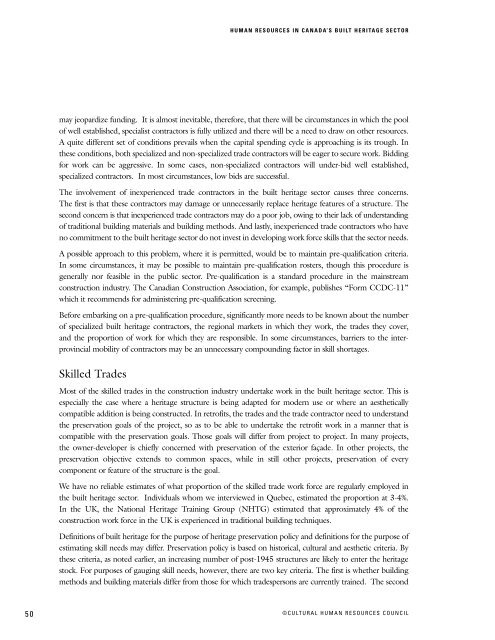Human Resources in Canada's Built Heritage Sector: Mapping the ...
Human Resources in Canada's Built Heritage Sector: Mapping the ...
Human Resources in Canada's Built Heritage Sector: Mapping the ...
- No tags were found...
You also want an ePaper? Increase the reach of your titles
YUMPU automatically turns print PDFs into web optimized ePapers that Google loves.
HUMAN RESOURCES IN CANADA’S BUILT HERITAGE SECTORmay jeopardize fund<strong>in</strong>g. It is almost <strong>in</strong>evitable, <strong>the</strong>refore, that <strong>the</strong>re will be circumstances <strong>in</strong> which <strong>the</strong> poolof well established, specialist contractors is fully utilized and <strong>the</strong>re will be a need to draw on o<strong>the</strong>r resources.A quite different set of conditions prevails when <strong>the</strong> capital spend<strong>in</strong>g cycle is approach<strong>in</strong>g is its trough. In<strong>the</strong>se conditions, both specialized and non-specialized trade contractors will be eager to secure work. Bidd<strong>in</strong>gfor work can be aggressive. In some cases, non-specialized contractors will under-bid well established,specialized contractors. In most circumstances, low bids are successful.The <strong>in</strong>volvement of <strong>in</strong>experienced trade contractors <strong>in</strong> <strong>the</strong> built heritage sector causes three concerns.The first is that <strong>the</strong>se contractors may damage or unnecessarily replace heritage features of a structure. Thesecond concern is that <strong>in</strong>experienced trade contractors may do a poor job, ow<strong>in</strong>g to <strong>the</strong>ir lack of understand<strong>in</strong>gof traditional build<strong>in</strong>g materials and build<strong>in</strong>g methods. And lastly, <strong>in</strong>experienced trade contractors who haveno commitment to <strong>the</strong> built heritage sector do not <strong>in</strong>vest <strong>in</strong> develop<strong>in</strong>g work force skills that <strong>the</strong> sector needs.A possible approach to this problem, where it is permitted, would be to ma<strong>in</strong>ta<strong>in</strong> pre-qualification criteria.In some circumstances, it may be possible to ma<strong>in</strong>ta<strong>in</strong> pre-qualification rosters, though this procedure isgenerally nor feasible <strong>in</strong> <strong>the</strong> public sector. Pre-qualification is a standard procedure <strong>in</strong> <strong>the</strong> ma<strong>in</strong>streamconstruction <strong>in</strong>dustry. The Canadian Construction Association, for example, publishes “Form CCDC-11”which it recommends for adm<strong>in</strong>ister<strong>in</strong>g pre-qualification screen<strong>in</strong>g.Before embark<strong>in</strong>g on a pre-qualification procedure, significantly more needs to be known about <strong>the</strong> numberof specialized built heritage contractors, <strong>the</strong> regional markets <strong>in</strong> which <strong>the</strong>y work, <strong>the</strong> trades <strong>the</strong>y cover,and <strong>the</strong> proportion of work for which <strong>the</strong>y are responsible. In some circumstances, barriers to <strong>the</strong> <strong>in</strong>terprov<strong>in</strong>cialmobility of contractors may be an unnecessary compound<strong>in</strong>g factor <strong>in</strong> skill shortages.Skilled TradesMost of <strong>the</strong> skilled trades <strong>in</strong> <strong>the</strong> construction <strong>in</strong>dustry undertake work <strong>in</strong> <strong>the</strong> built heritage sector. This isespecially <strong>the</strong> case where a heritage structure is be<strong>in</strong>g adapted for modern use or where an aes<strong>the</strong>ticallycompatible addition is be<strong>in</strong>g constructed. In retrofits, <strong>the</strong> trades and <strong>the</strong> trade contractor need to understand<strong>the</strong> preservation goals of <strong>the</strong> project, so as to be able to undertake <strong>the</strong> retrofit work <strong>in</strong> a manner that iscompatible with <strong>the</strong> preservation goals. Those goals will differ from project to project. In many projects,<strong>the</strong> owner-developer is chiefly concerned with preservation of <strong>the</strong> exterior façade. In o<strong>the</strong>r projects, <strong>the</strong>preservation objective extends to common spaces, while <strong>in</strong> still o<strong>the</strong>r projects, preservation of everycomponent or feature of <strong>the</strong> structure is <strong>the</strong> goal.We have no reliable estimates of what proportion of <strong>the</strong> skilled trade work force are regularly employed <strong>in</strong><strong>the</strong> built heritage sector. Individuals whom we <strong>in</strong>terviewed <strong>in</strong> Quebec, estimated <strong>the</strong> proportion at 3-4%.In <strong>the</strong> UK, <strong>the</strong> National <strong>Heritage</strong> Tra<strong>in</strong><strong>in</strong>g Group (NHTG) estimated that approximately 4% of <strong>the</strong>construction work force <strong>in</strong> <strong>the</strong> UK is experienced <strong>in</strong> traditional build<strong>in</strong>g techniques.Def<strong>in</strong>itions of built heritage for <strong>the</strong> purpose of heritage preservation policy and def<strong>in</strong>itions for <strong>the</strong> purpose ofestimat<strong>in</strong>g skill needs may differ. Preservation policy is based on historical, cultural and aes<strong>the</strong>tic criteria. By<strong>the</strong>se criteria, as noted earlier, an <strong>in</strong>creas<strong>in</strong>g number of post-1945 structures are likely to enter <strong>the</strong> heritagestock. For purposes of gaug<strong>in</strong>g skill needs, however, <strong>the</strong>re are two key criteria. The first is whe<strong>the</strong>r build<strong>in</strong>gmethods and build<strong>in</strong>g materials differ from those for which tradespersons are currently tra<strong>in</strong>ed. The second50©CULTURAL HUMAN RESOURCES COUNCIL










